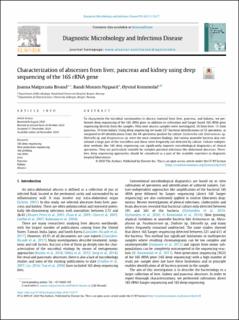Characterization of abscesses from liver, pancreas and kidney using deep sequencing of the 16S rRNA gene
Journal article, Peer reviewed
Published version

View/
Date
2021Metadata
Show full item recordCollections
- Department of Clinical Science [2395]
- Registrations from Cristin [10399]
Original version
Diagnostic Microbiology and Infectious Disease. 2021, 99 (3), 115277. 10.1016/j.diagmicrobio.2020.115277Abstract
To characterize the microbial communities in abscess material from liver, pancreas, and kidneys, we performed deep sequencing of the 16S rRNA gene, in addition to cultivation and Sanger based 16S rRNA gene sequencing directly from the samples. Fifty-nine abscess samples were investigated, 38 from liver, 11 from pancreas, 10 from kidney. Using deep sequencing we made 227 bacterial identifications in 52 specimens, as compared to 69 identifications from the 44 specimens positive by culture. Escherichia coli, Enterococcus sp., Klebsiella sp. and Streptococcus sp. were the most common findings, but various anaerobe bacteria also constituted a large part of the microflora and those were frequently not detected by culture. Culture-independent methods like 16S deep sequencing can significantly improve microbiological diagnostics of clinical specimens. They are particularly valuable for complex purulent infections like abdominal abscesses. Therefore, deep sequencing approaches should be considered as a part of the available repertoire in diagnostic hospital laboratories.
